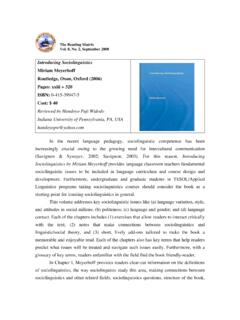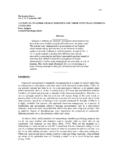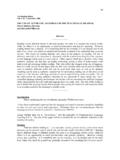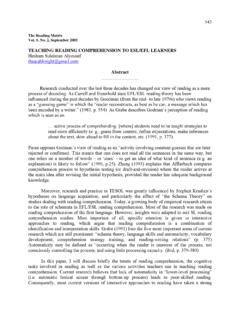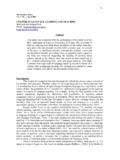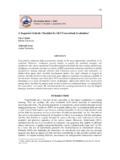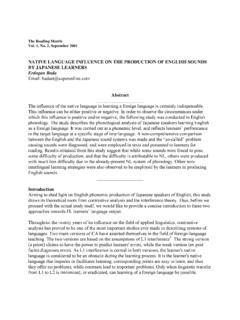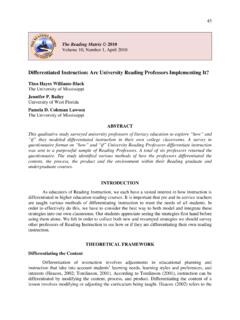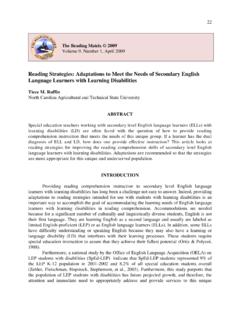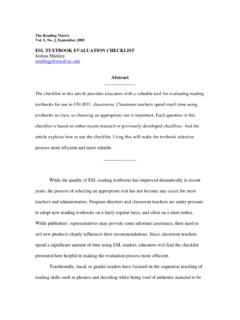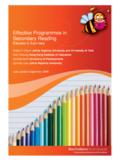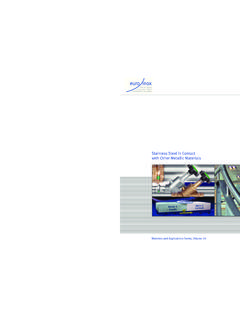Transcription of THE EFFECTS OF THE ACCELERATED READER ... - …
1 87 The Reading Matrix , November 2003 THE EFFECTS OF THE ACCELERATED READER PROGRAM ON THE READING COMPREHENSION OF PUPILS IN GRADES THREE, FOUR, AND FIVE Roger A. Johnson Email: Carol A. Howard Abstract _____ Many students continue to struggle with acquiring the necessary skills to become successful readers. The most commonly used software for teaching reading is the ACCELERATED READER (AR). This study investigated the effect of the AR program on the reading achievement and vocabulary development of 755 third, fourth, and fifth graders from a low socio-economic, urban environment. Students categorized as high AR users gained significantly more on reading comprehension than those students categorized as average and/or low users. The results indicate that the AR program can be quite effective if the participating students are willing to do supplemental reading. _____ Introduction The National Reading Panel (2000) states that reading comprehension is critically important to the development of children s reading skills and therefore to the ability to obtain an education.
2 Slavin, Karweit, Wasik`, Madden, and Dolan (1994) note that students who complete the third grade and lack reading skills are not likely to graduate from high school. Furthermore, American school children without high levels of reading comprehension face a difficult and uncertain economic future. As Bronfenbrenner, McClelland, Wethington, Moen, and Ceci (1996) note, In a technological society, the demands for higher literacy are constantly increasing, creating ever more grievous consequences for those who fall short and contributing to the widening economic disparities in our society. Recreational reading programs are designed to encourage the development of the reading habit. Reading is a skill that requires much practice to perfect. Activities to practice reading should bring both success and enjoyment to all children in order to foster an ongoing interest in reading. Van Riel (2001, pp.)
3 30- 31) coined the term READER development in the l980s. She 88 believes that students should have active intervention to open up reading choices, increase READER s enjoyment, and offer opportunities for people to share their reading experiences. These supplemental reading programs are generally inexpensive, non-competitive, and allow students to develop skills at their own pace. Minimal assistance of a teacher is required. The ACCELERATED READER (AR) program (Paul, VanderZee, Rue & Swanson, 1996) is the most commonly used recreational/motivational reading program. According to the Education Commission of the States (1999), approximately 43,000 schools (one of three) throughout the United States are currently using the ACCELERATED READER (AR) program. The AR program (Paul et al. 1996) combines a literature-based reading program with the use of a computer to provide detailed reports to parents, teachers, and administrators on each child s reading progress.
4 The purpose of this is to offer students appropriate recreational reading as a means of encouraging reading achievement gains. Students that read sufficient numbers of books often receive awards such as certificates of achievement, ribbons, picture-taking, or pizza parties. The AR was developed by Paul and his associates at the Institute for Academic Excellence. (Paul, et al. 1996). Paul and his associates have conducted several studies using large numbers of subjects that all purport to show the effectiveness of the AR program. Paul et al. (1996) compared students in 2500 elementary, middle, and high schools in Texas that had adopted the AR software with their counterparts in 3500 schools that did not own the AR software. The Texas schools with and without the AR programs were of similar geographic and demographic characteristics. Students in the AR schools outperformed their counterparts on the Texas Assessment of Academic Skills Test that was administered in grades 3-8 and in the 10th grade.
5 However, the differences between the school performance was not examined in enough detail to determine statistical significance. In addition, although a preliminary version of these findings have been presented at educational conferences, the findings have not been subjected to peer review associated with a refereed journal. In 1997 Paul, Swanson, Zhang, and Hehenberger noted that several hundred Tennessee grade schools that had purchased the AR program outperformed their counterparts. In 1999 Paul, owner of the AR, and Topping evaluated the effectiveness of the AR in 2193 schools across the United States. Topping and Paul (1999) found that AR students spent more time on reading than their counterparts who were not enrolled in AR programs. Next, Topping (Vollands, Topping, and Evans, 1999) investigated the use of the AR with sixth-grade students in an economically distressed area of Scotland.
6 The two sixth grade classes that used the AR had greater gains in reading than their counterparts that did not use the AR program. However, since there had only been a marginal implementation of the AR program, the differences between the AR classrooms and the controls may have been attributed to other variables. 89 Evaluations of the AR program by researchers other than by Paul and his associates are less supportive. Outside evaluations have employed less subjects, and resulted in mixed findings. Peak and Dewalt (1994) compared 50 ninth graders who had received five years of AR instruction with 50 ninth graders who had not received AR instruction. The authors used a multiple regression statistical test, and concluded that some of the differences between reading scores can be attributed to the program. However, Peak and Dewlat (1994) did not provide the READER with multiple regression outcomes nor did they explain why they used this particular multivariate statistics.
7 Five recent studies of the AR program report positive findings. It appears that library use and/or reading levels increase after the introduction of the AR program. (Anderson, 2001; Ganter, 2000; and Lawson, 2000). Facemire (2000) and Scott (1999) both report that student reading levels increased after the introduction of the AR program. However, these positive findings are challenged by less recent studies which report negative and/or nonsignificant findings for classrooms using the AR. Using 30 students, Mathis (1996) failed to find any statistical significant increase in reading comprehension from the fifth to the sixth grade. Rosenheck, Caldwell, Calkins, and Perez (1996) found that neither the frequency of library use nor attitudes toward reading improved after the AR had been in place. Prince and Barron (1998) postulate that the use of the widely known ACCELERATED READER Program alone cannot create lifelong learners.
8 Although the AR and the Electronic Bookshelf may increase library use and standardized test scores, according to Carter (1996), both programs tended to diminish student motivation, restrict title choice of books, and overemphasize testing. In summary, there have been several large scale studies carried out by Paul (the owner of the AR software) and his associates which reported positive findings. In addition, several recent small scale AR evaluations (Anderson, 2001; Ganter, 2000; Lawson, 2000; Facemire, 2000; and Scott, 1999) have reported that reading scores and/or library use has increased following the introduction of the AR. On the other hand, three recent evaluations of the AR (Mathis, 1996; Rosenheck, et al. 1996; Price and Barron, 1998; and Carter, 1996) question its effectiveness. Due to the conflicting findings of past studies and the widespread use of the AR program in US schools, further insight into its effectiveness is necessary.
9 If the AR program is only marginally effective, then students should be spending valuable classroom time on other pedagogical reading techniques, and/or monies should be used to hire additional educational personnel and/or purchase additional library books. The purpose of this study was to determine whether the AR program was effective, and whether its effectiveness was dependent upon the amount of student usage. More specifically, did students classified as Low users and Average users gain as much on reading comprehension measures as students classified as High users? 90 Method Students that participate in the AR program choose their own books from the ACCELERATED READER book list, which contains more than 12,000 titles. Each of the 12,000 books is assigned a point value based on its length and the Flesch-Kincaid reading index to determine readability (Flesch, 1974, p. 23). Students read selected books at their own pace and then take a test on the computer.
10 The computer test consists of multiple choice questions about important facts in the book. Most of the questions evaluate literal comprehension. In order to earn any points on a book, the student must answer at least 60 percent of the questions correctly on the test. Careful test writing and security features in the software greatly reduce the possibility of student cheating. AR points are therefore a fairly accurate measure of the quantity of words being read and comprehended. Students may only test once for a given book. If students read too quickly, they score poorly because they are not reading with comprehension. When implemented according to design, teachers are expected to oversee students reading patterns. If a child s test scores are too low, teachers intervene with advice on reading level and rates. The computer scores the test, calculates the number of points earned by each student, and records the data.
